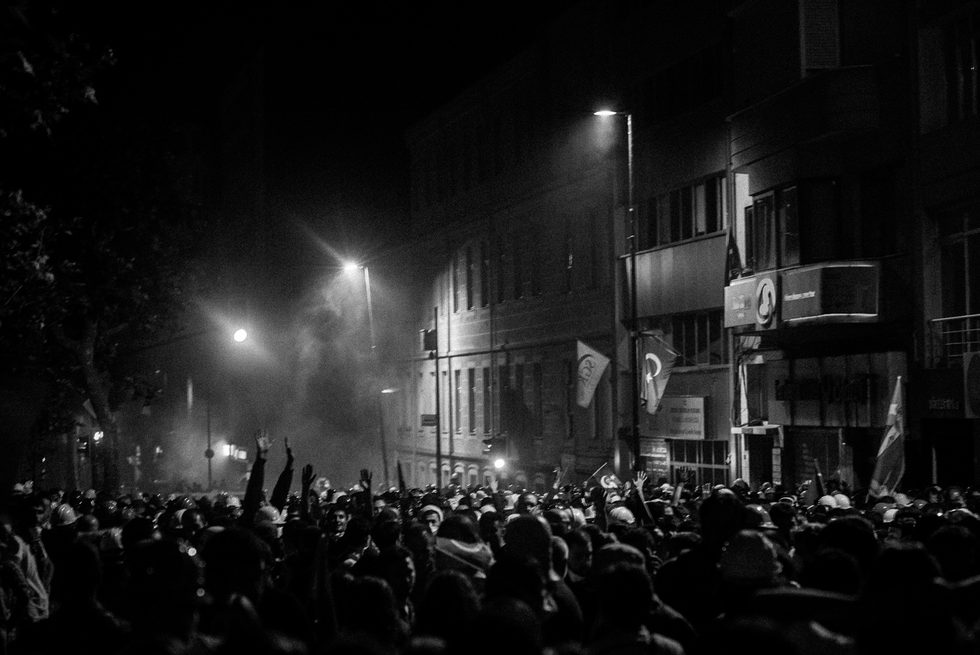The Politics of Visibility
From the Series: An Impromptu Uprising: Ethnographic Reflections on the Gezi Park Protests in Turkey
From the Series: An Impromptu Uprising: Ethnographic Reflections on the Gezi Park Protests in Turkey

Politics is not merely about logos. The “partition of the sensible” divides bodies into two categories, “those that one sees and those that one does not see, those who have a logos—memorial speech, an account to be kept up—and those who have no logos” (Rancière 1999, 22). What was at stake in the Gezi resistance was not only the visibility of those whose lives aren’t grievable, but also of the event itself. An event that couldn’t be articulated into a signifier chain was stifled by “organized lying” (Arendt 1993, 251–59). Its visibility was stalled through violence and distorted through discourse, which articulated it into a chain according to which what needs to be seen, felt, thought, and signified was preordained. Direct experience was barred. The management of visibility controlled the signification of the event, pinning it to available structures without letting new meanings emerge.
One reason why the state resented the mobilizations was because they embodied the constative “we exist.” This was conveyed by a banner at the LGBTT Pride march in Istanbul: “Gays exist! Kurds exist!” The “collective thereness” (Butler 2012) of bodies refusing to be disposed of was a manifestation of endurance, but also a demand for existing as part of a larger totality. Assembling in public spaces presupposes the gaze. The ultimate effect of Gezi hinged upon whether or not the protestors’ performances through speech and deed could become visible. From the point of view of the actors, the protests were the embodiment of an unexpected “we” emerging from bodily presence, but not controlled, mastered, fully grasped by any of society’s conventional identities or ideologies. The government rejected the principles that “we” were evoking. The struggle was about securing the conditions that would make the protest take effect in the Austinian sense (1962)—become an effective reality to be reckoned with.
The paradoxical reinsertion and leveling out of differences also disrupted the partition of the sensible. The condition of possibility of communality was the experience of resisting itself. Mete, who was offended by a conscientious objector at a forum, was interpellated by a speaker as such: “Didn’t we struggle at the same barricades together? Didn’t we risk our lives when facing the same police? Well then, you must listen. I don’t have to like the army and I want to express this here.” The leveling that committed each to letting the other be seen and heard owed to deed rather than speech. The divisiveness of speech was thwarted by recalling the bond between bodies as the more genuine ground of engagement. Or rather, the bodily bond made the divisiveness of speech more tolerable and manageable.
Conventional identities started existing qua difference when their bodies fought the police. For instance, LGBTT individuals were present with their flags and drag outfits at a barricade when the police started taking over.[1] Leftists and football fans were taken aback. Some of them said to the LGBTTs, “You’re the most organized group here. You must go up front to halt the police while we gather our forces.” Fans even spread the word that the “boy in the skirt has a first-aid kit.” The movement acquired a non-representative nature through this differential demand for visibility. This wasn’t a demand for recognition, but for taking part in the collective making of a “we”—the demand to be an actor. The very presence of the LGBTTs embodied a demand addressed to the football fans who, in asking them to go up front, were already responding positively. In contrast to representative and governmental forms of politics, Gezi epitomized “the political” as such, since interactions could not be negotiated through available norms. Gezi operated a disruption, a rift that ushered in “liminality” (Turner 1974, 47) and summoned the exercise of judgment or virtuosity. It corresponded therefore to Arendt’s (1958) construal of the political as the acting together of a plurality of beings whose identities or standpoints are not fixed, but are constituted and reconstituted by virtue of relating to each other in liminal spaces.
And yet, the Kurds qua Kurds didn’t choose this path to visibility. Gezi also operated a partition between those who were willing to compromise and those who were still experiencing an invisible war, which the former have yet to reckon with.
1. Related by a protestor and in a slightly different manner in a published interview: eXpress, no. 136, June–July 2013: 60–61.
Hannah Arendt, The Human Condition, Chicago: University of Chicago Press, 1958.
Hannah Arendt, Between Past and Future, New York: Penguin Books, 1993.
J. L. Austin, How To Do Things With Words, Oxford: Oxford University Press, 1962.
Judith Butler, “A Politics of the Street,” lecture delivered at the Peter Wall Institute for Advanced Studies, Vancouver, British Columbia, May 24, 2012.
Jaucques Rancière, Disagreement: Politics and Philosophy, Minneapolis: University of Minnesota Press, 1999.
Victor Turner, Dramas, Fields and Metaphors: Symbolic Action in Human Society, Ithaca, N.Y.: Cornell University Press, 1974.